Imagine you had six Lego bricks – you know, those 2 x 4 rectangular kind that you spent hours with as a kid? Now, could you guess how many different combinations you might possibly create out of those six little plastic bricks?
The answer is 915 million.
Notice how you didn’t need to be told what Lego was, even though it’s a child’s toy? It’s because Lego’s famous plastic brick has been around for more than 60 years. Today, close to 100 million children in 140 different countries play with Lego toys.
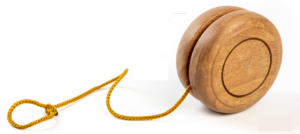
It might also surprise you to learn that Lego, the largest toymaker in the world by sales and profits, is family-owned.
This is the story of the Kirk Kristiansen family of Denmark.
Anyone in business knows that it takes the right combination of ingenuity, innovation, and relentlessness to make a company successful – and even more so for one of the world’s iconic companies and brands. It hasn’t always been easy for Lego. There have been a few times throughout its history that the company has had to dismantle what it built and start again. Add to that the challenges of being a family-controlled enterprise – and the story is captivating.
The Kirk Kristiansens have a long history of bringing the next generation into Lego early – and encouraging their involvement. But they’ve also had to make some tough decisions through the years – including choosing outsiders over family members to be the leaders of the operational side (the day-to-day affairs) of Lego.
All the while, the Kirk Kristiansens have retained control of their family business. They continue to tinker and adjust the family ownership model to make it work. The family has demonstrated an uncompromising focus on the long-term, allowing them to pull ahead of their competitors.
Today, Lego employs more than 17,000 people around the world. It posted revenues of CAD $7.18 billion in 2018. Lego has production facilities from Denmark to China, Hungary to Mexico, and primary offices in Connecticut, London, Shanghai, and Singapore. The brand is truly iconic.
The little brick has come a long way.
So what has made the Kirk Kristiansens – and Lego – so successful for almost 90 years?
How a tiny toy got so big
What has grown over time to be a massive company had, like many family businesses, humble beginnings. Lego originated with a young Danish carpenter, Ole Kirk Christiansen, in the midst of the early years of the Depression. It was 1932. Ole lived in Billund, a small town in rural Jutland, a Danish peninsula connected to northern Germany. He was part of a poor family and had nine siblings.
Ole’s early carpentry business was mostly focused on restoring old buildings and constructing new ones, as well as making household items such as ladders and ironing boards. But the Depression reduced demand for these products, so Ole looked for alternatives. He began to make wooden toys, including piggy banks, Yo-Yos, and toy trucks, for which demand stayed steady, along with the household items.
Ole soon held a competition at the factory to name the company, but in 1934 came up with the name himself. Lego comes from two Danish words – leg godt – which mean “play well.” (In Latin, “lego” means “I put together” or “I assemble.” Ole didn’t know this when he named the company, but how appropriate it would become!)
His original Lego bricks were wooden until the company bought a plastic injection molding machine in 1947.
Three years later, Ole suffered a stroke, and the family turned its attention to succession. Ole decided that one of his three sons – Godtfred Kirk Christiansen, then an operations manager at the company – would eventually lead Lego. In 1950 he promoted Godtfred to junior vice president, assigning him additional responsibilities.
Godtfred officially assumed the reins from his father in 1957, becoming managing director. The company was shifting into the next generation after 25 years.
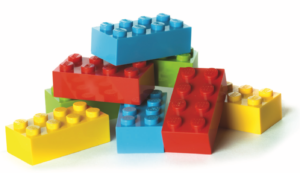
Meanwhile, throughout the 1950s, the company had been working on a “system of play,” whereby any Lego brick could fit with any other set, and the more Lego bricks you had, the more you could build. The interlocking plastic bricks that are familiar to many of us today were introduced and patented by Godtfred in 1958. Unfortunately, Ole didn’t live to see it. He died just a few months before the interlocking bricks system was launched.
Godtfred soon oversaw Lego’s global expansion. While the toys were already in Norway and Sweden, he focused on moving the toys onto shelves in other European countries, starting with Germany. Godtfred also oversaw the introduction of Lego to the U.S. in 1961. The company originally made an agreement with Samsonite, the luggage manufacturer, to sell Lego in the U.S. and Canada. By 1974, the Lego Group set up its own subsidiary in Connecticut, and began manufacturing bricks there in the early 1980s.
Also emblematic of this time of expansion – Lego actually opened its own private airport in the early 1960s. It enabled international business-people (and buyers) to visit Billund easily and frequently.
By 1964 the airport had grown to such a size that its ownership was transferred to a new company and made public. Today, it’s the second largest international airport in Denmark.
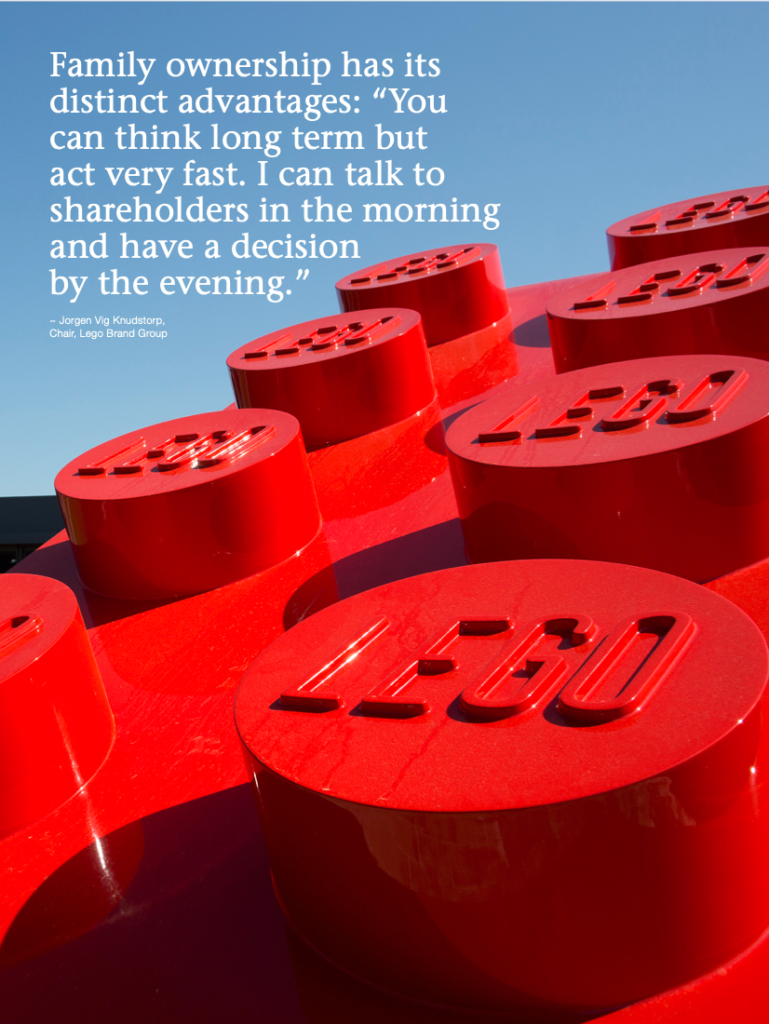
The advent of outside management
A further indicator of growth came in 1973. It marked the first time the Kirk Kristiansen family brought in an outsider to serve as Lego CEO, acting as a bridge between Godtfred and his son, Kjeld Kirk Kristiansen. Vagn Holck Andersen served as head for six years, until Kjeld was ready to assume the mantle of Lego’s leadership. (Kristiansen was spelled with a ‘K’ on Kjeld’s birth certificate, and from that time forward became the official spelling of the family name.)
Kjeld grew up testing the appeal of Lego toys with his sisters, and his picture even appeared on some of the boxes of Lego sets in the 1950s. He eventually obtained his MBA and worked in the management group at Lego Switzerland, before joining the Lego Group management in Denmark in 1977. Two years later, at 31, Kjeld took over from Holck. He would run the company for the next 25 years.
Kjeld is also credited with making significant reorganizational changes at Lego, including making Duplo its own brand and the rapid globalization of the Lego brand. The company experienced huge growth under his leadership until the early 1990s.
While the family, under Kjeld, resumed the day-to-day operational leadership of the company at this time, they were also solidifying their control of the family business for future generations. Kirkbi, the family’s investment company, was founded in the 1980s. Today, Kirkbi owns 75 per cent of Lego. The charitable Lego Foundation owns the other 25 per cent. Kirkbi also owns stakes in a wide range of other companies and a 30 per cent stake in Merlin Entertainment, the owner of Legoland theme parks.
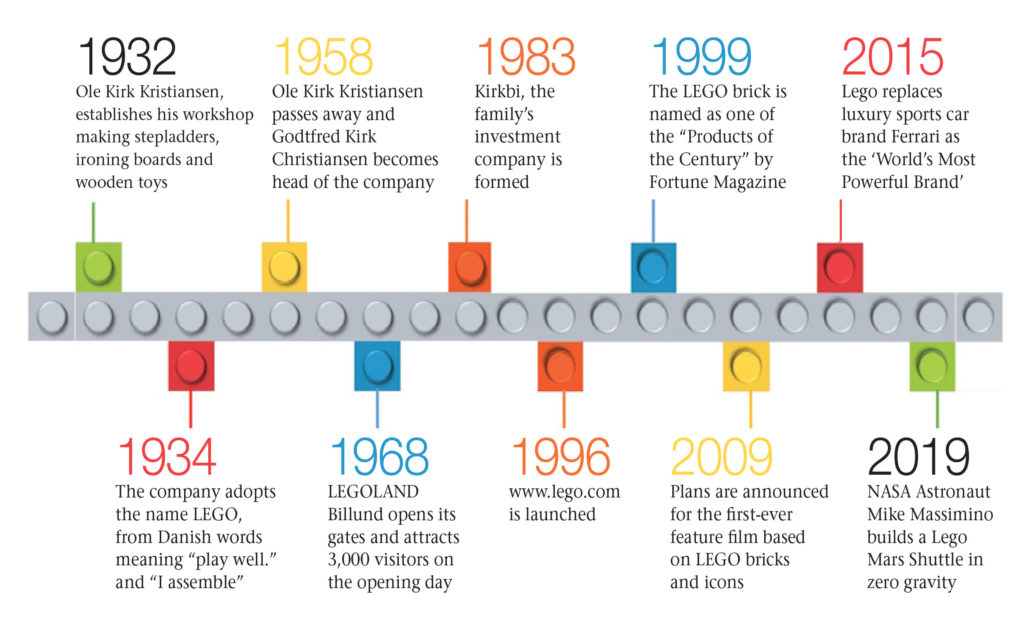
But then came some hiccups
Lego began to face financial trouble in the early 1990s, caused by a series of issues, including the expiration of Lego’s patent on the plastic brick, and the increasing popularity of digital games. By 1998, the Lego Group reported its first deficit since its founding, and the family brought in an outsider, Poul Plougmann, to serve as the company’s director of finance.
The bleeding didn’t stop. In 2004 the family recruited a new chief executive, its second from outside the family ranks. Jorgen Vig Knudstorp was a former McKinsey consultant and soon expressed the urgency of the situation to the directors of the company: “We are on a burning platform.”
The appointment of Knudstrop seemed to work. He soon turned the company around, quadrupling revenue in less than 10 years. It’s another example of how the Kirk Kristiansen family has focused on the long-term potential of the brand. Knudstorp has said that although he always discussed any big decisions with the family, the owners trusted him to act in the best interests of Lego. And family ownership also had its distinct advantages: “You can think long term but act very fast,” he told the Financial Times in 2011. “I can talk to shareholders in the morning and have a decision by the evening.”
Kjeld Kirk Kristiansen and Jorgen Vig Knudstorp seemed to forge a shared understanding of operating a family business. Kjeld recognized that though the company performed well under Knudstorp’s leadership, further setbacks were always possible. Knudstorp told the Financial Times in 2016 that Kjeld had a saying: “As a family owner, if you want to own something for 150 years, there will always be another crisis.”
Through it all, Lego has benefited from the long-term focus of its owners. Knudstorp said in a 2015 interview with Egon Zhender, an international leadership advisory firm, that the Kirk Kristiansen family has always been willing to make investments in Lego because they know it’s the right thing to do and will benefit the company many years into the future.
The sustainability challenge
Over the years there have been no shortage of challenges for Lego. The increasing popularity of digital and online play, concerns about sustainability, and the collapse of toy retailers such as Toys R Us, mean that the company continues to innovate and adapt to stay ahead. It’s telling that the manufacturer of simple plastic bricks is still one of the world’s leading toymakers.
The company is blending physical and digital play, integrating mobile apps, and experimenting with augmented reality. Lego is also pushing into Asia in a big way, particularly China. In 2019 Lego will open 80 stores in 18 Chinese cities. The company has further plans to expand in the Middle East and other countries, including India.
Lego also has a storied history on the sustainability front. In the 1960s the company formed a marketing partnership with Shell, selling Shell-branded Lego sets. But 50 years later, Greenpeace targeted Shell with an ad campaign that used Lego bricks to build an Arctic landscape that was then destroyed with oil. In 2014, Lego ended its partnership with Shell. It created new sustainability goals for the company and partnered with organizations like the World Wildlife Fund.
Since then, the centerpiece of Lego Group’s sustainability plan has become the Sustainable Materials Center, which is tasked with finding alternatives to the plastics Lego uses in its toys. The goal is to have a solution in place by 2030. Lego has already invested about CAD $200 million into the project.
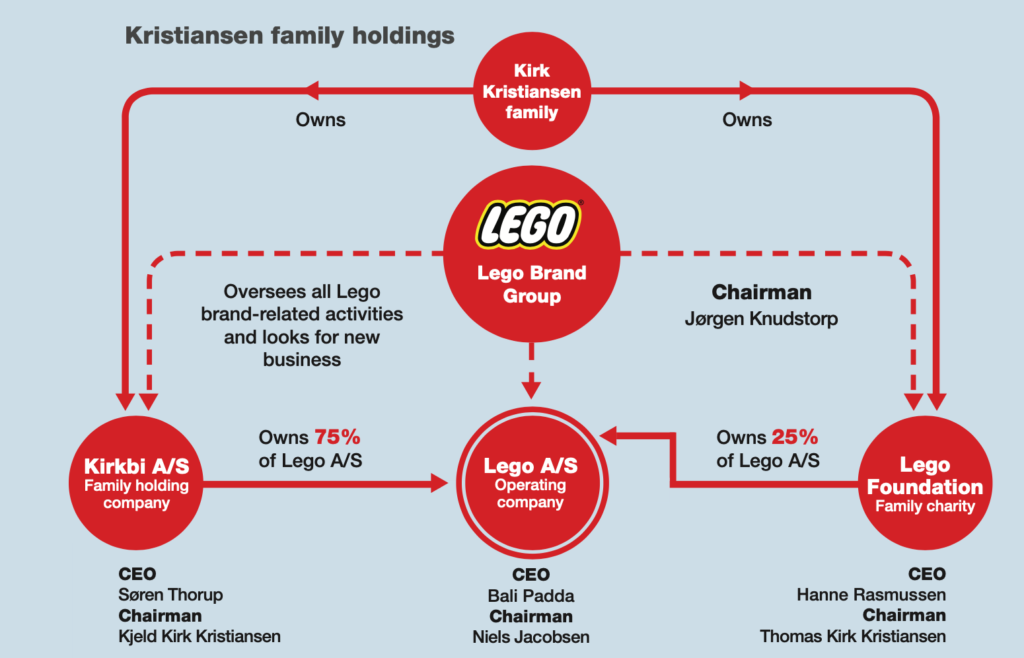
A remarkable commitment to family transparency
While the operational managers of Lego continue to innovate, helping the company to adapt and thrive in this new environment, the Kirk Kristiansen family continues on its own path – ensuring the long-term success and enduring family control of the company.
In the early 2000s, the family developed a plan to have each generation appoint one representative, known as the “most active owner.” This person would be well acquainted with the company and decision-making, and act as a spokesperson for the family and an ambassador for the Lego brand.
In Kjeld’s family, his son, Thomas Kirk Kristiansen, carries this responsibility. Thomas is described as the “most active owner” for the fourth generation. As with generations before him, Thomas has taken on increasing responsibilities in the family business over many years. He joined the Lego Group’s board as, first, an observer and then as a director in 2007. Thomas became deputy chairman of the Lego Group, as well as chair of the Lego Foundation, in 2016.
Kjeld now serves as the chair of Kirkbi, the family’s private holding and investment company. It’s expected that Thomas will take over as chair of Kirkbi after his father steps down.
Kirkbi itself has become remarkable, in recent years, for its commitment to openness and transparency. Its website (www.kirkbi.com) publishes a full accounting of the family’s business interests, plus rich, detailed information on the family’s ownership structure (see accompanying graphic) mission, vision, principles, leadership team and other details.
It’s rare for a privately owned family holding company to be so transparent and open about its activities and principles. It seems to strike to the core of what the Kirk Kristiansen family stands for.
A family building for the long term
As the most active owner for the fourth generation, Thomas also represents the family in the appointment of board members and management for Lego, Kirkbi, and the Lego Foundation. The Kirk Kristiansen family still retains the right to choose the CEO and board for Lego, and for making certain “cultural” decisions. A member of the Kristiansen family will always chair Kirkbi, but an outsider chairs the Lego board.
Jorgen Vig Knudstorp, the former CEO, is currently the chair of the board of the Lego Brand Group, a new entity created in 2017. It collects all of the family’s Lego-related interests together and has two purposes: (1) to develop, leverage, and protect the Lego brand; and (2) to encourage ongoing family engagement in the business. Knudstorp says family engagement is as important as ever, and that the entity will ensure that the family remains an “active owner, one who smells the roses, who knows what the business, the culture are like.”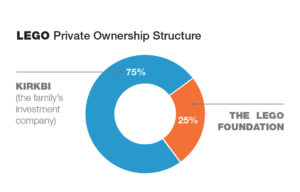
The Kirk Kristiansens have consistently groomed successors within their own ranks, since Ole Kirk Christiansen brought in his son in the 1950s. It’s a strategy that has kept the business familyowned through almost 100 years. While the family will certainly face challenges in the future, they’re building a structure that is sure to sustain the Kirk Kristiansen name. They have enjoyed great success when bringing in non-family members to operate the company, while keeping the holding company family-run.
Most of all, the Kirk Kristiansens continue to work to engage younger generations and focus on long-term growth. They’re keeping family members interested and growing with the company, ensuring a pipeline of emerging talent. And Lego continues to innovate, to thrive in a world that looks very different from when it began almost 100 years ago.
As the family puts it on Kirkbi’s website:
Over the years, new activities have developed and others have stopped, but in spite of all changes, the family ownership as well as the long-term perspective and the fundamental values rooted in the family have been a steady force and a driver behind the Kirk Kristiansen enterprises – the LEGO Group, the LEGO Foundation, LEGO Education and KIRKBI.
Clearly the Kirk Kristiansens are building for its future success, brick by brick.
Questions to consider for your business:
- What is your family’s approach to outside management for the operating company?
- Is it important to you to have the next generation involved in the family business?
- If so, how are you preparing them?
Sarah Reid is a freelance writer based in Toronto.
